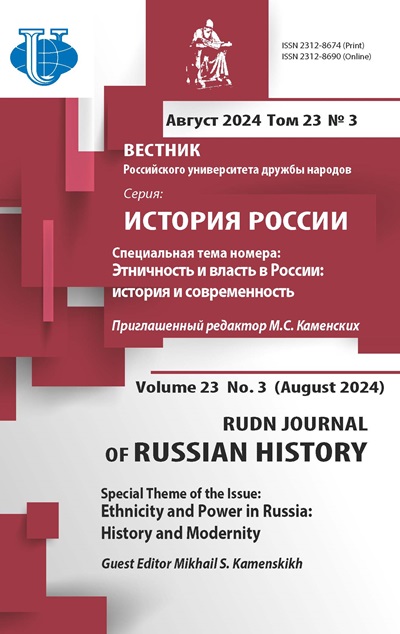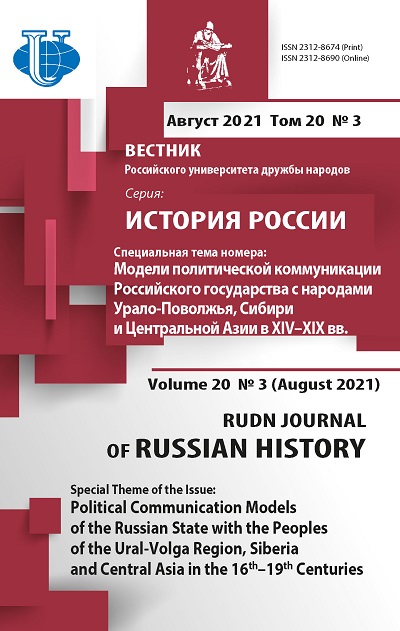Siberian Bukharans in Russian mission: gathering intelligence in Russia’s south-eastern borderlands, 17th-18th centuries
- Authors: Puzyrev I.D.1,2
-
Affiliations:
- National Research University Higher School of Economics
- Tyumen Scientific Center of the Siberian Branch of the Russian Academy of Sciences
- Issue: Vol 20, No 3 (2021): Political Communication Models of the Russian State with the Peoples of the Ural-Volga Region, Siberia and Central Asia in the 16th–19th Centuries
- Pages: 388-398
- Section: Political Communication Models of the Russian State with the Peoples of the Ural-Volga Region, Siberia and Central Asia in the 16th–19th Centuries
- URL: https://journals.rudn.ru/russian-history/article/view/27270
- DOI: https://doi.org/10.22363/2312-8674-2021-20-3-388-398
Cite item
Full text / tables, figures
Abstract
Siberian Bukharans were one of the most agile group of the native population of Western Siberia and the Urals in the 17th and 18th centuries. This paper analyzes information about the border activities of Bukharans, characterizes their participation in the implementation of Russian foreign policy. The author considers the phenomenon of “intelligence” and the intermediary and diplomatic role of the Bukharans through the study of various aspects of Russian policy on the southeastern borderlands. The result shows that Bukharans were involved in intelligence activities in several forms. The Russian authorities could interview Bukharans who came to trade; they could include Bukharans in Russian embassies; or they could send them into the steppe as independent agents. The geography of their missions in the 17th and 18th centuries included the Kuchum lands, the Kazakh khanates, the Oirat and Dzungar lands, as well as the Qing Empire. Bukharans participated in the negotiations as interpreters and they were sometimes allowed to participate in diplomatic ceremonies such as gift exchange. The intelligence activities of some Bukharans could go hand in hand with their trade operations. Recruiting Bukharans for intelligence gathering tsks allowed the Siberian and Orenburg authorities to conduct a more effective policy in the steppe borderlands, based on the knowledge of local realities. The Russian authorities used information provided by the Bukharans for purposes such as drawing up maps, informing the voivodes of the borderlands about military dangers, the movement of troops, and diplomatic negotiations.
Keywords
About the authors
Ivan D. Puzyrev
National Research University Higher School of Economics; Tyumen Scientific Center of the Siberian Branch of the Russian Academy of Sciences
Author for correspondence.
Email: ipuzyrev@hse.ru
Junior researcher of the Federal Research Center, Tyumen Scientific Center of the Siberian Branch of the Russian Academy of Sciences; PhD student of the Department of History, National Research University Higher School of Economics in St. Petersburg.
17, Promyshlenaya St., St. Petersburg, 198095, Russia; 86, Malygina St., Tyumen, 625003, RussiaReferences
- Bahrushin, S.V. Nauchnie Trudy, vol. 4. Moscow: AN SSSR Publ., 1959 (in Russian).
- Bakieva, G.T. “ ‘To be in Tobolsk among Tatar chiefs…’ (From the family history of the Tatar servicemen Kulmametev).” Siberian Historical Research, no. 4 (2015): 10–29 (in Russian).
- Belyakov, A.V., and Maslyuzhenko, D.N. “Siberian-Bukharan-Nogai Relations in the Light of Correspondence between Abdallah, the Khan of Bukhara, and Kuchum, the Khan of Siberia.” Stratum Plus, no. 6 (2016): 229–243.
- Bukanova, R.G. Goroda-kreposti yugo-vostoka Rossii v XVIII veke. Istoriia stanovleniia gorodov na territorii Bashkirii. Ufa: Kitap Publ., 1997 (in Russian).
- Burbank, J., and Cooper, F. Empires in World History: Power and the politics of difference. Princeton University Press, 2010.
- Bustanov, A.K. “Speaking Bukharan: Persian texts in Imperial Russia.” Islam in the modern world 12, no. 4 (2016): 81–92.
- Bustanov, A.K., and Korusenko, S.N. “Genealogies of the Siberian Bukharans: the Shikhovs.” Archaeology, Ethnology and Anthropology of Eurasia, no. 4 (2014): 140–149 (in Russian).
- Erofeeva, I.V., and Zhanaev, B.T. Istoriia Kazakhstana v russkikh istochnikakh XVI–XX vekov. Vol. 6 of Putevye dnevniki i sluzhebnye zapiski o poezdkakh po yuzhnym stepyam. XVIII–XIX veka. Almaty: Dajk-press Publ., 2007 (in Russian).
- Frank, A. “Varieties of Islamization in Inner Asia: The Case of the Baraba Tatars, 1740–1917.” Cahiers du Monde Russe 41, no. 2/3 (Apr.-Sep., 2000): 245–262.
- Hafizova, K.S. Stepnye vlastiteli i ikh diplomatiia v XVIII–XIX vekakh. Nur-Sultan: KISI pri Prezidente RK Publ., 2019 (in Russian).
- Hafizova, K.S., and Moiseev, V.A. eds. Tsinskaia Imperiia i kazakhskie khanstva. Vtoraia polovina XVIII – pervaia chetvert' XIX vv., prt. 1 Alma-Ata: Nauka Publ., 1989 (in Russian).
- Konev, A.Y., and Slugina, V.A. “ ‘Zhalovannoe slovo’ v nakazah sibirskim voevodam: k voprosu o proiskhozhdenii i evolyucii formulyara.” In Aktual'nye problemy otechestvennoj istorii, istochnikovedeniya i arheografii: k 90-letiyu N.N. Pokrovskogo. Novosibirsk Rossiiskaia: Akademiia Nauk, Sibirskoe otdelenie, Institut istorii Publ., 2020, pp. 183–193 (in Russian).
- Krih, A.A. “Exploration Activity of the Siberian Bukharians in the Kirghiz Steppe in the 18th Century.” Herald of Omsk University. Series “Historical Studies,” no. 2 (2019): 35–42. doi: 10.25513/2312-1300.2019.2.35-42 (in Russian).
- Makhmutov, Z.A. “The roles and activities of Tatar mullahs in Kazakhstan, 18th to mid-21st century.” RUDN Journal of Russian History. 20, no. 1 (2021): 61–73 (in Russian).
- Miller, G.F. Istoriia Sibiri, vol. 1. Moscow: Vostochnaia literature Publ., 1999 (in Russian).
- Potanin, G.N. “O karavannoi torgovle s Dzhungarskoi Bukhary v XVIII stoletii.” In Chteniia v Imperatorskom Obshchestve Istorii i Drevnostei Rossiiskikh, book 2, prt. 5. Moscow: Universitetskaia tipografiia Publ., 1868, pp. 21–113 (in Russian).
- Potanin, G.N. Materialy dlia istorii Sibiri. Moscow: Universitetskaia tipografiia Publ., 1867 (in Russian).
- Puzyrev, I.D. “O nachal'nom periode shertovaniia sibirskikh bukhartsev.” Voprosy istorii Sibiri, vol. 16. Omsk: OmGPU Publ., 2019, pp. 140–144 (in Russian).
- Ross, D. Tatar Empire: Kazan's Muslims and the Making of Imperial Russia. Indiana University Press, 2020.
- Sirik, V.A., ed. Sultany i batyry Srednego zhuza (vtoraia polovina XVIII v.): sbornik dokumentov. Almaty: Litera-M Publ., 2018 (in Russian).
- Taymasov, S.U. Bashkirsko-kazahskie otnosheniya. Moscow: Nauka Publ., 2009 (in Russian).
- Trepavlov, V.V. Sibirskii yurt posle Ermaka: Kuchum i Kuchumovichi v bor'be za revansh. Moscow: Vostochnaya literature Publ., 2012 (in Russian).
- Tyzhnov, I.I. Ocherki po istorii Srednei Sibiri XVII–XVIII stoletii. Tomsk: Tomskogo universiteta Publ., 2013 (in Russian).
- Vasil'ev, A.D. Znamia i mech ot padishakha. Politicheskie i kul'turnie kontakty khanstv Tsentral'noi Azii i Osmanskoi imperii (seredina XVI – nachalo XX vv.). Moscow: Institut Vostokovedeniia RAN Publ., 2014 (in Russian).
- Vas'kov, D.A. “Otpiska tobol'skikh voevod o russkikh posol'stvakh k sibirskomu tsarevichu Devlet-Gireyu v 1645–1646 gg.” Vestnik Novosibirskogo gosudarstvennogo universiteta. Seriya: Istoriya, filologiya 14, no. 1 (2015): 158–166 (in Russian).
















